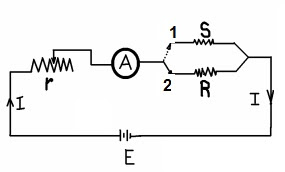In Substitution Method, the Resistance whose value is to be measured is compared with the Standard Resistance by some technique which is described in this section. The connection diagram for Substitution Method is given below.
Here, R is the unknown Resistance, S the Standard variable Resistance, A is Ammeter and r is Regulating Resistance.
When we put the Switch at position 1 then R is connected in the circuit. The Regulating Resistance r is adjusted till the reading of Ammeter is at a chosen scale mark. Now the Switch is thrown to position 2 putting the Standard variable Resistance S in the circuit. Now the variable Resistor S is adjusted till the reading of Ammeter is same as when R was in the circuit. The setting of dial of S is read. Since the substitution of one resistance for another has left current unaltered, and provided that EMF of battery and position of Regulating Resistance r remain unaltered, the two Resistance R and S must be equal. Thus the value of unknown Resistance R is equal to the dial setting of Standard Resistance S.
This method of measurement is more accurate as compared to the Ammeter Voltmeter Method as in this method measurement is not affected by the accuracy of Ammeter. However, the accuracy of this method is greatly affected if there is any change in the Battery EMF during the time when the reading in two settings is taken. Therefore to avoid the error because of change of EMF of Battery, a Battery of enough capacity is used so that it remains constant during the entire period of testing.
The accuracy of this method also depend on resistance of circuit excluding R and S, upon the sensitivity of instrument and upon the accuracy with which the Standard Resistance S is known.
This method is not widely used for simple Resistance measurement and is used in modified form for the measurement of High Resistance. The Substitution Method is however very important as it finds its use in application of bridge method and in high accuracy A.C measurement.
Example: In measurement of Resistance by Substitution Method, a standard 0.5 MOhm resistor is used. The Galvanometer has a resistance of 10 KOhm and gives raeding as follows:
- With Standard Resistor, 41 division
- With unknown resistor, 51 division.
What will be the value of unknown resistance?
Solution: As the deflection of Galvanometer is directly proportional to the current flowing through the circuit which in turn depends on the net resistance in the circuit. Current through the circuit is inversely proportional to the net resistance. Let say a1 is the deflection of Galvanometer when standard Resistor S is in circuit and a2 when unknown Resistance R is in circuit.
So, a1/a2 = (R+G)/(S+G) where G is Galvanometer resistance.
So, 41/51= (R+G)/(S+G)
R = (S+G)×41/51 = 0.4×106 Ohm = 0.4 MOhm

wow classic notes